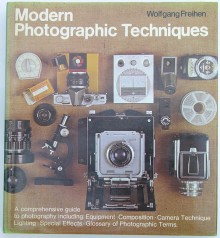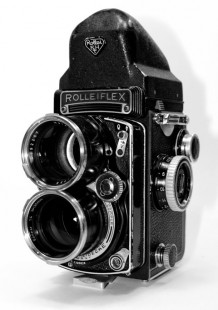Before talking about the “Aquamarin” housing itself, please let me give a short introduction to my beginning with underwater photography: When I started diving – or let me really say – with snorkelling first, I was just 12 years of age. At that time (1950) I was fascinated by the Hans Hass film “In the Red Sea”, and soon I experienced that snorkelling in inland lakes was just as fantastic too…
Two years later I built my first flexible underwater housing for a simple box camera. There was no viewfinder on it and I also couldn’t adjust the f-stop or the shutter speed. Therefore the first snap shots did not look very good; some were blurred and in some other cases, I had cut off the heads of my friends… No, these pictures were all together disappointing and so my next try was two years later, this time with a 35 mm camera in a self made steel housing. Of course, it was watertight and all adjustments could be operated from outside. Everything worked perfectly but anyhow, my first try with it ended in a disaster again: the housing was so heavy, that I reached the bottom of the swimming pool almost immediately, very much quicker than at any time before… To keep the camera in its position, I had to blow up a big water ball first. It looked like a big balloon, which I could hang it on. After this adventure followed my final try with a self-made underwater housing: it was similarly constructed and made of aluminium, a little bit different in its dimensions, because this time I also took care about buoyancy, and this time it was absolutely perfectly constructed and was used for several years…
In the early 60’s I started diving with breathing gear. I had just finished my studies as a mechanical engineer, and six months later I married. During this time we furnished our new flat, but before also buying a new kitchen, I was of the opinion, it would be better, to buy instead the most sophisticated underwater camera of this time, a “Rolleiflex 3.5 F” together with its “Rolleimarin IV” underwater housing and the adjustable flash. To control the image during the dive on its big focussing screen was absolutely fantastic! In fact, it was the best housing I ever had in my hands!! I used the pictures taken on our honeymoon in the Mediterranean for one of my first lectures, followed by many others later on, and half a year later I had enough money again, to then buy our kitchen…
During that time I also wrote my first articles, first in the only existing German diving magazine, the “Delphin” and then later on in some others. Two calendars followed and also nine books about diving and both normal and also underwater photography. Some were translated into the Dutch and the English language, too. “Modern Photographic Techniques” for instance, was even available with Book Club Associates, London.
I used the “Rolleimarin” camera for least 20 years on all my different voyages. At that time it was considered as the world’s most common underwater camera but as time went on, the disadvantages became more and more visible: Normal photographic techniques had overtaken the capabilities of the twin-lens “Rolleiflex”, and in the end we even liked to use all these technical advances under water: 12 pictures at one single dive were definitely too few. Therefore I sometimes took three cameras at the same time down with me. Also the fixed, built-in-lens of 80 mm gave too few possibilities for picture arrangements. Well, a German manufacturer of underwater housings could modify the camera together with its housing for use with 220 films too and Peter H. Krause, another well-known German underwater photographer, showed how to use a wide angle converter lens in front of the normal lens but despite such modifications – the possibilities of the “Rolleimarin” were still much too limited…
The only way out of this dilemma was to buy another camera. Due to the still existing advantages of the 6x6 cm film format against the smaller 35 mm films, I decided to buy a 6x6 cm single-lens-reflex camera. There were only two top models on the market: The “Hasselblad” and the “Rollei SL 66”. I decided for myself, that the “Rollei SL 66” with its focal plane shutter had the advantage over the “Hasselblad” with a between-the-lens shutter, because of the built-in accordion-like extendable tube. With this particular device I could use the camera without any modification at all different ranges, from close-ups up to infinity. This was very important, because you never know underwater, which opportunity you will face as your next …
As compared to the “Rollei SL 66”, a “Hasselblad” could only be used under water for normal distances or for close-up pictures – never for both possibilities during the same dive… For example if a “Hasselblad” was equipped with extension tubes in-between the lens and the camera body or with ancillary lenses, you would never have the possibility to also take a snapshot of a passing shark and in the case that the camera was prepared for normal distances only, you could never take beautiful close-ups during the same dive… In other words: its use was always very limited… On the other hand The “Hasselblad” with its between-the-lens shutter was better for flash light synchronisation. Even when, flash light photography is not common, it is really the normal way with underwater photography, my decision was clearly for the “Rollei SL 66”…
Different to the “Rolleimarin”, the “Aquamarin” housing was not manufactured at the Rolleiwerke in Braunschweig, but made in Darmstadt, Germany. The founder of this company, named “Oceanoptics”, was Wulf Koehler, a well-known German sport diver and underwater photographer. I bought a housing second-hand, because a friend of mine sold it, as he liked to use another housing instead, called “Trilobite”, which was made by a different German manufacturer. As opposed to the latter one, the “Aquamarin” housing consisted of only two parts, a front and a rear part, instead of three sections. This was in my opinion a big advantage, because only one big O-ring gasket instead of two, in-between the partitions, guarantees 50% more safety for the camera itself when underwater… (continued in part 2)

